
By Denise Rosenfeld, Reliawire, Aug 23, 2015 – Ten years after Hurricane Katrina formed in the Atlantic, NASA engineers have begun building the first of eight next-generation hurricane-observing micro-satellites. NASA’s Cyclone Global Navigation Satellite System (CYGNSS) mission, is intended to improve hurricane forecasting by making measurements of ocean surface winds in and near the eye of tropical cyclones, typhoons and hurricanes throughout their life cycle.
For the first time, CYGNSS will enable scientists to examine the inner core of hurricanes from space, using both direct and reflected signals from existing GPS satellites to obtain estimates of surface wind speeds over the ocean. These measurements will advance forecasting methods by providing data that can lead to better predictions of hurricane tracks, intensities and storm surges.
The CYGNSS mission earlier this summer successfully passed two major NASA reviews. This clears the way for integration, testing and preparation of the microsatellites for flight. Said Chris Ruf, CYGNSS principal investigator at the University of Michigan, Ann Arbor:
“These reviews were a major milestone for CYGNSS, marking the end of the detailed design and planning stages of the mission and the beginning of flight hardware assembly. We are now in the last phase of the mission prior to launch and the beginning of a new era in hurricane observations.”
The satellites will be stacked for testing in early 2016, and the mission is scheduled to launch in late 2016 on an Orbital ATK Pegasus XL expendable rocket from Cape Canaveral in Florida. Science operations are to begin in the 2017 Atlantic hurricane season.
Assembly of the first microsatellite began Aug. 14, with the other seven to follow in the next few weeks. The body of each satellite measures roughly 20-by-25-by-11 inches, slightly larger than a standard carry-on suitcase.
When fully assembled, each satellite will weigh about 64 pounds. With the solar panels deployed, the microsatellites will have a wingspan of 5.5 feet.
As the CYGNSS and GPS satellites circle Earth, their interaction will provide a new image of wind speeds over the entire tropics every few hours, whereas a single satellite supplies a new image every few days.
The ability to better monitor and predict the rapid changes in hurricane intensity, such as those observed with Hurricane Katrina, is critical to hurricane forecasters and U.S. coastal communities.












